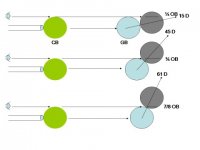Edge of the CB aiming.
If you line up center of the CB to the center of the OB you can shoot the straight in shot.
If you line up with the center of the CB to the right edge of the OB (CTE) you can shoot a 30 degree cut angle to the left.
If your eyes are 2.25” apart and can stroke the cue in between under you chin and between your eyes, you can then use the edges (3:00 and 9:00) of the CB to aim with.
You can aim the left edge of the CB at the left edge of the OB with your cue to the right side of that aim line, with the tip of the cue aimed at the center of the CB, and shoot a straight in shot. The cue will be parallel to the left edge aim line.
If you can aim the left edge of the CB at the center of the OB, you can shoot a 30 degree cut angle to the left for the cue will be aimed at the right edge of the OB (CTE).
If you aim the left edge of the CB at the right edge of the OB you can shoot a 90 degree cut angle to the left.
This means that by aiming the left edge of the CB at points on the equator of the OB from the left edge to the right edge, you can effect all of the cut angle required to send the OB to the left – the reverse is also true for cutting the OB to the right.
Using this method of aiming, you can then aim the left edge of the CB at the fractions on the OB, like ¼ and ¾ (we already covered the left edge, center and right edge).
Having memorized the resulting cut angles for ¼ and ¾ and the shot looks like it is a bit to the right or left, then try 1/8, 3/8, 5/8 or 7/8 or what ever you have stored in your memory of the resulting cut angles produced for you by all of those fractions – including 1/3 and 2/3.
Oh yeah, unlike GB aiming, all of the aim points/fractions are visible on the OB and not off to the outside of the edge of the OB on the cloth somewhere.
Try it. It might work for you.
Be well.


If you line up center of the CB to the center of the OB you can shoot the straight in shot.
If you line up with the center of the CB to the right edge of the OB (CTE) you can shoot a 30 degree cut angle to the left.
If your eyes are 2.25” apart and can stroke the cue in between under you chin and between your eyes, you can then use the edges (3:00 and 9:00) of the CB to aim with.
You can aim the left edge of the CB at the left edge of the OB with your cue to the right side of that aim line, with the tip of the cue aimed at the center of the CB, and shoot a straight in shot. The cue will be parallel to the left edge aim line.
If you can aim the left edge of the CB at the center of the OB, you can shoot a 30 degree cut angle to the left for the cue will be aimed at the right edge of the OB (CTE).
If you aim the left edge of the CB at the right edge of the OB you can shoot a 90 degree cut angle to the left.
This means that by aiming the left edge of the CB at points on the equator of the OB from the left edge to the right edge, you can effect all of the cut angle required to send the OB to the left – the reverse is also true for cutting the OB to the right.
Using this method of aiming, you can then aim the left edge of the CB at the fractions on the OB, like ¼ and ¾ (we already covered the left edge, center and right edge).
Having memorized the resulting cut angles for ¼ and ¾ and the shot looks like it is a bit to the right or left, then try 1/8, 3/8, 5/8 or 7/8 or what ever you have stored in your memory of the resulting cut angles produced for you by all of those fractions – including 1/3 and 2/3.
Oh yeah, unlike GB aiming, all of the aim points/fractions are visible on the OB and not off to the outside of the edge of the OB on the cloth somewhere.
Try it. It might work for you.
Be well.


Last edited: